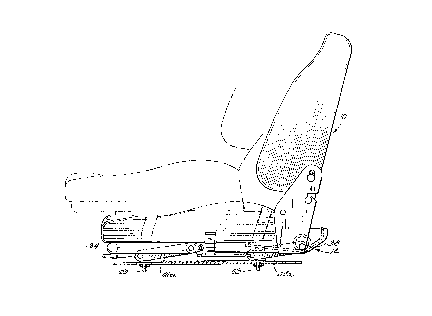Some of the information on this Web page has been provided by external sources. The Government of Canada is not responsible for the accuracy, reliability or currency of the information supplied by external sources. Users wishing to rely upon this information should consult directly with the source of the information. Content provided by external sources is not subject to official languages, privacy and accessibility requirements.
Any discrepancies in the text and image of the Claims and Abstract are due to differing posting times. Text of the Claims and Abstract are posted:
| (12) Patent: | (11) CA 2053052 |
|---|---|
| (54) English Title: | VEHICLE SEAT ASSEMBLY INCLUDING HEIGHT ADJUSTMENT MECHANISM |
| (54) French Title: | ASSEMBLAGE DE SIEGE DE VEHICULE COMPRENANT UN MECANISME DE REGLAGE DE LA HAUTEUR |
| Status: | Expired and beyond the Period of Reversal |
| (51) International Patent Classification (IPC): |
|
|---|---|
| (72) Inventors : |
|
| (73) Owners : |
|
| (71) Applicants : |
|
| (74) Agent: | MACRAE & CO. |
| (74) Associate agent: | |
| (45) Issued: | 2001-03-27 |
| (22) Filed Date: | 1991-10-09 |
| (41) Open to Public Inspection: | 1992-07-09 |
| Examination requested: | 1998-07-15 |
| Availability of licence: | N/A |
| Dedicated to the Public: | N/A |
| (25) Language of filing: | English |
| Patent Cooperation Treaty (PCT): | No |
|---|
| (30) Application Priority Data: | ||||||
|---|---|---|---|---|---|---|
|
A vehicle seat support assembly for supporting a seat
for vertical adjustable movement. The seat support assembly
includes lower mounting rails which are fixed to the vehicle
and an upper seat supporting frame to support a vehicle seat.
Pivot links connected between the mounting rails and the upper
seat supporting frame support the seat supporting frame for
vertical movement with respect to the mounting rails. A
locking rail locks the vertical position of the upper seat
supporting frame with respect to the lower mounting rails. The
locking rail includes a fixed second portion and a first
portion fixed to the upper seat supporting frame which is
movable forwardly and rearwardly with respect to the second
portion of the locking rail.
Note: Claims are shown in the official language in which they were submitted.
Note: Descriptions are shown in the official language in which they were submitted.

2024-08-01:As part of the Next Generation Patents (NGP) transition, the Canadian Patents Database (CPD) now contains a more detailed Event History, which replicates the Event Log of our new back-office solution.
Please note that "Inactive:" events refers to events no longer in use in our new back-office solution.
For a clearer understanding of the status of the application/patent presented on this page, the site Disclaimer , as well as the definitions for Patent , Event History , Maintenance Fee and Payment History should be consulted.
| Description | Date |
|---|---|
| Inactive: IPC from MCD | 2006-03-11 |
| Inactive: IPC from MCD | 2006-03-11 |
| Time Limit for Reversal Expired | 2002-10-09 |
| Letter Sent | 2001-10-09 |
| Grant by Issuance | 2001-03-27 |
| Inactive: Cover page published | 2001-03-26 |
| Inactive: Final fee received | 2000-12-20 |
| Pre-grant | 2000-12-20 |
| Notice of Allowance is Issued | 2000-11-23 |
| Notice of Allowance is Issued | 2000-11-23 |
| Letter Sent | 2000-11-23 |
| Inactive: Approved for allowance (AFA) | 2000-11-01 |
| Amendment Received - Voluntary Amendment | 1998-11-10 |
| Inactive: Application prosecuted on TS as of Log entry date | 1998-08-28 |
| Letter Sent | 1998-08-28 |
| Inactive: Status info is complete as of Log entry date | 1998-08-28 |
| All Requirements for Examination Determined Compliant | 1998-07-15 |
| Request for Examination Requirements Determined Compliant | 1998-07-15 |
| Application Published (Open to Public Inspection) | 1992-07-09 |
There is no abandonment history.
The last payment was received on 2000-09-27
Note : If the full payment has not been received on or before the date indicated, a further fee may be required which may be one of the following
Please refer to the CIPO Patent Fees web page to see all current fee amounts.
| Fee Type | Anniversary Year | Due Date | Paid Date |
|---|---|---|---|
| MF (application, 6th anniv.) - standard | 06 | 1997-10-09 | 1997-08-27 |
| Request for examination - standard | 1998-07-15 | ||
| MF (application, 7th anniv.) - standard | 07 | 1998-10-09 | 1998-09-17 |
| MF (application, 8th anniv.) - standard | 08 | 1999-10-11 | 1999-09-24 |
| MF (application, 9th anniv.) - standard | 09 | 2000-10-10 | 2000-09-27 |
| Final fee - standard | 2000-12-20 |
Note: Records showing the ownership history in alphabetical order.
| Current Owners on Record |
|---|
| SEATS INCORPORATED |
| Past Owners on Record |
|---|
| HAROLD VANDUSER |